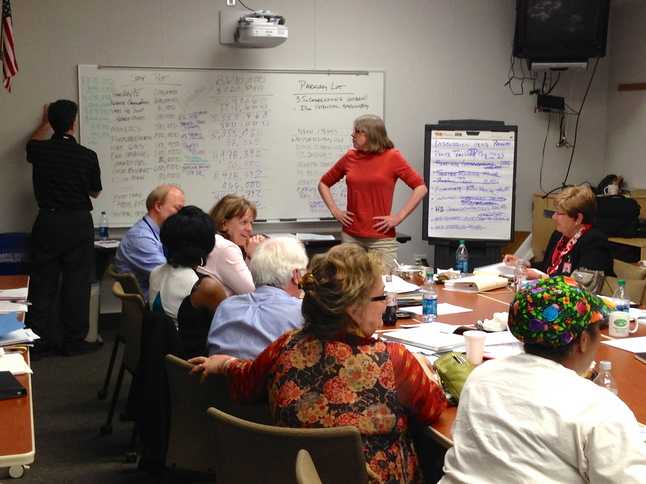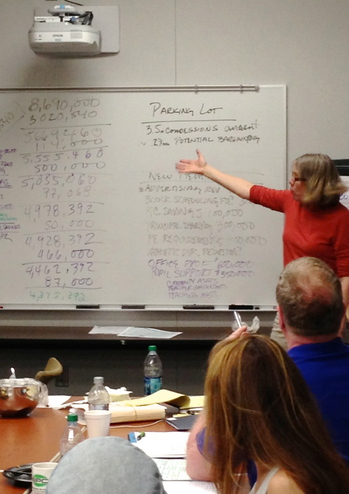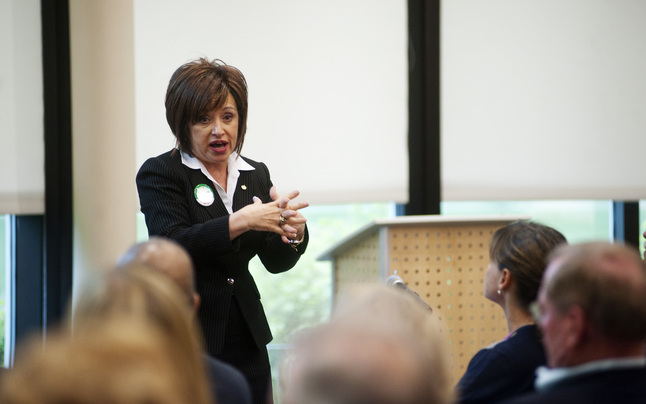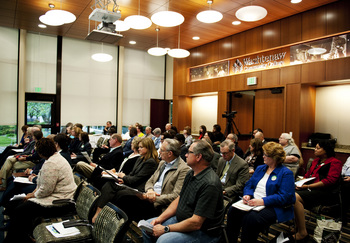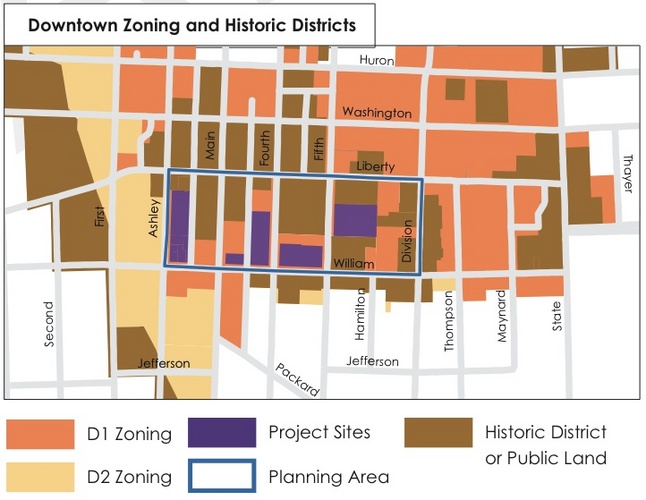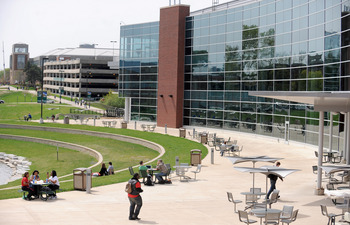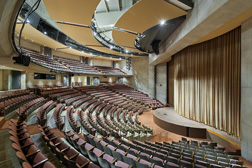The Washtenaw County Board of Commissioners pulled a resolution from its Ways and Means agenda Wednesday night that would have been the first step to issuing a $345 million bond for long-term retiree benefit liabilities.
Citing the need for more public input in the process and the mid-June release of a new actuary report, Board Chairman Yousef Rabhi announced the issue would be pushed to the board’s July 10 meeting for a first vote.

Yousef Rabhi
Andrew Kuhn | For AnnArbor.com
At the May 2 working session of the board, commissioners were presented with a proposed payment plan for a $345 million bond issue by the county’s bond counsel, led by lawyer John Axe of Axe & Ecklund.
The bond would be used to cover long-term liabilities the county has accrued in its retiree health care and pension plans. The county’s bond counsel has claimed it would reduce the county’s expenditures by $112 million over the next 25 years.
Wednesday night, the board was set to consider the first step in the process, which would be a first vote on a letter of intent to issue bonds.
The second and final vote on the letter of intent would have been June 5 - before the release of the new actuary report that would give the county a better estimate on how much their unfunded liability is.
“There were really some concerns about the timeline being too aggressive and for the public not having time to discuss it,” Rabhi said.
Health care and pension liabilities
Washtenaw County has been accruing an unpaid liability in its funds for retiree health care and pensions, which it pays for using general fund revenues and returns on trust funds.
The trust fund returns have not been great enough to cover the health care and pension costs. Although the county has made its annual general fund contribution to the funds, the actuary report had set the required payment schedule too low, said County Administrator Verna McDaniel.
Both plans have been capped as a result of the contract negotiations the county executed with the vast majority of its unions this spring that came about because of the right-to-work implementation deadline.
The 2011 actuary report defined the county’s unfunded liabilities as $101.4 million for the defined benefit pension plan, and $148.5 million for the retiree health plan.
Fully funding both of those liabilities on a 25-year payment schedule would require about $340 million.
Bond payments
Instead of paying back a growing, fluctuating pension and health care debt directly, the county is considering paying back the debt in fixed interest payments on bonds.
The county is looking to reduce its expenditures - which could be to the tune of $112 million, according to an estimate compiled in a report done by Meredith Shanle, president of Municipal Financial Consultants Incorporated.
Issuing bonds for the debt assumes that the rate of return - which is dependent on the market - will be greater than the rate at which the bonds were borrowed.
The Municipal Financial Consultants proposal assumes a rate of return of 6.5 percent.
Should the county choose to go into debt by bonding, it would be paying $344 million in principal with an additional $238.9 million payment in interest for a total payment of $583.1 million over 25 years.
Those payments would be made from the county’s general fund at the current operating millage rate that the county levies. Should the county pursue limited tax bonds, the county would not have to get voter approval to issue them.
In 2013, the county paid a combined total of $22.3 million to both its retiree health care and pension contributions.
Without bonding, the county is facing a payment of $30.7 million to those funds in 2014 - an increase that McDaniel said would mean millions of dollars would have to be cut from the county’s services and staff.
The projected bond payment for 2014 would be about $18.5 million, according to the Municipal Financial Consultants proposal.
Risks
The ability of a municipality to bond for such long-term debt was made possible by Public Act 329, which was signed into law in October.
There are safeguards in the law, including the qualification that a municipality must have a bond rating of AA or higher. Washtenaw County has a Aa1 Moody’s rating and a AA+ Standard & Poor rating.
The Michigan Municipal League was supportive of the passage of Act 329 because of the local finance control it gives to local bodies of government, said Anthony Minghine, chief operations officer of the MML in an interview with AnnArbor.com.
“It’s not without risk. You make a number of assumptions in determining how much you borrow,” Minghine said. “ You assume you’re getting a particular rate of return.”
Univerisity of Michigan Ross School of Business Professor Robert Dittmar said in an interview with AnnArbor.com that one of the biggest risks the county would face would be investing its money safely to guarantee a profitable rate of return.
“The assumption that they’re making is that there’s a spread between what they’ll pay on the bond issuance and the income they’ll make on the bond proceeds,” Dittmar said. “The biggest risk right now is that it’s difficult to find relatively safe investments. It’s difficult to find something to invest in to generate the income in order to have this make sense.”
Dittmar said the worst-case scenario would be if the county did not get a good return on its investment and had to cover more of the payments for the debt issue. That would require more diversion of general fund cash flows to the payments - which would result in a cut to county services and operations, Dittmar said.
“Or, eventually you go bankrupt,” he said. “The investment return on the issue needs to be sufficiently high so that the county doesn’t have to divert cash flows to debt payment.”
Minghine said now is an almost perfect time for Washtenaw County to issue bonds for its long-term unfunded liabilities.
“We’re at historically low interest rates,” Minghine said. “Money’s almost free at this point. When you combine this with a marketplace where investment returns are good at this point - it’s almost a perfect time.”
As the payment schedule for the bond would be set at the time of issuance, the county would be able to plan for its general fund expenditures years in advance, adding a measure of stability to the county’s budget, McDaniel said.
The county’s direct payments to its retiree health care and pension plans fluctuate now based on actuary reports and market rates.
“Done correctly, it can be a great tool,” Minghine said. “If you don’t do this, you have an annual changing number that you’re dealing with.”
Though there is no other option being pursued by the county to pay off its unfunded liabilities, the county is also seeking an independent consultant to review the bond proposal, McDaniel said.
A worst-case scenario analysis for the bond issue is also being compiled, McDaniel said.
Public input
Since the county announced it was pursuing the $345 million bond issue at its May 2 meeting, there have been many questions to county commissioners and county staff on the issue - which prompted the board to take more time to engage the public in the discussion, Rabhi said.
Under the new course of action outlined by Rabhi Wednesday night, there will be two future public hearings on the bond issue: 6:45 p.m. June 5 and July 10.
A presentation to the public on the bond issue will also be a part of the engagement process, though a date has not yet been set.
“We want your feedback and your questions,” Rabhi said in an address to the commissioners and to the general public. “We’re postponing this action to give the community the ability to fully evaluate the pros and cons.”
Rabhi will also begin hosting coffee hours to talk through concerns with residents about the bond issue, which he has named “Bonding over coffee.” The first session has yet to be announced, but will likely begin after Memorial Day, Rabhi said.
July 10 will be the next time the Board of Commissioners considers bond-related resolutions in its Ways and Means meeting. A second meeting was added to that month for July 24 to allow the board to give a final vote on the bond issues.
Amy Biolchini covers Washtenaw County, health and environmental issues for AnnArbor.com. Reach her at (734) 623-2552, amybiolchini@annarbor.com or on Twitter.

